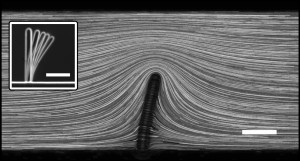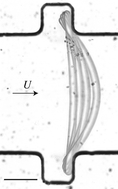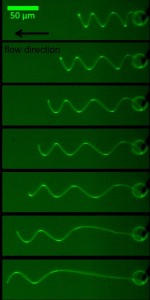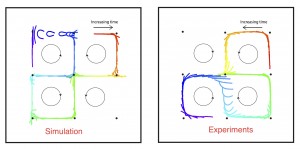Wexler, J. S., Trinh, P. H., Berthet, H., Quennouz, N., du Roure, O., Huppert, H. E., Lindner, A. & Stone, H. A.
Journal of Fluid Mechanics, (2013) 720, 517–544. doi:10.1017/jfm.2013.49

We present a mathematical model and corresponding series of microfluidic experiments examining the flow of a viscous fluid past an elastic fibre in a three-dimensional channel. The fibre’s axis lies perpendicular to the direction of flow and its base is clamped to one wall of the channel; the sidewalls of the channel are close to the fibre, confining the flow. Experiments show that there is a linear relationship between deflection and flow rate for highly confined fibres at low flow rates, which inspires an asymptotic treatment of the problem in this regime. The three-dimensional problem is reduced to a two-dimensional model, consisting of Hele-Shaw flow past a barrier, with boundary conditions at the barrier that allow for the effects of flexibility and three-dimensional leakage. The analysis yields insight into the competing effects of flexion and leakage, and an analytical solution is derived for the leading-order pressure field corresponding to a slit that partially blocks a two-dimensional channel. The predictions of our model show favourable agreement with experimental results, allowing measurement of the fibre’s elasticity and the flow rate in the channel.
 ue to engineer monodisperse, superparamagnetic, micron-sized prisms of arbitrary cross-section and large magnetic susceptibility. The fabrication process allows pre-positioning of the particles that introduces another lever to guide self-assembly. In this method, a dispersion of magnetic colloids in a UV-curable monomer is molded in PDMS wells and subsequently reticulated. High homogeneous magnetic content is achieved by preventing colloidal aggregation through careful choice of the colloid and monomer. Additionally, on their removal from the PDMS molds, the relative position of the magnetic particles is conserved: they are extracted as arrays whose patterns are set by the PDMS mold. This novel method therefore offers unique control of the self-assembly of specific ‘higher order’ structures mediated by dipolar interactions and directed by the geometry and initial positioning of the particles. This is also a promising approach to develop devices with complex responses to external fields.
ue to engineer monodisperse, superparamagnetic, micron-sized prisms of arbitrary cross-section and large magnetic susceptibility. The fabrication process allows pre-positioning of the particles that introduces another lever to guide self-assembly. In this method, a dispersion of magnetic colloids in a UV-curable monomer is molded in PDMS wells and subsequently reticulated. High homogeneous magnetic content is achieved by preventing colloidal aggregation through careful choice of the colloid and monomer. Additionally, on their removal from the PDMS molds, the relative position of the magnetic particles is conserved: they are extracted as arrays whose patterns are set by the PDMS mold. This novel method therefore offers unique control of the self-assembly of specific ‘higher order’ structures mediated by dipolar interactions and directed by the geometry and initial positioning of the particles. This is also a promising approach to develop devices with complex responses to external fields.
 Pham, J.T., Morozov, A., Crosby, A.J., Lindner, A. & du Roure, O.
Pham, J.T., Morozov, A., Crosby, A.J., Lindner, A. & du Roure, O. Quennouz N., Shelley M.J., du Roure, O. & Lindner, A.
Quennouz N., Shelley M.J., du Roure, O. & Lindner, A. Home
Home